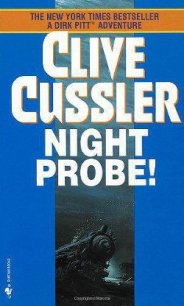The Mayan Secrets - Cussler Clive (читать бесплатно полные книги TXT) 📗
“I could feel them staring at us.”
Sam smiled. “You could feel them staring at you, more likely. You should be used to that.”
That evening, Sam and Remi began their exploration of the city’s nightlife with the Plaza Mayor, right outside their hotel. They sampled the coffee in the Continental, then went for pinchos, the favorite local iteration of tapas, at Restaurante Los Zagales. They were made of morcilla sausages, red onion, and pork rind, all wrapped into a roll.
Each day, Sam and Remi walked from the Zenit Imperial Hotel and returned to the History Library to examine the next group of five-hundred-year-old books.
After the library closed that afternoon, Sam and Remi returned to their hotel for a nap, then got up at ten to begin their evening of exploring. That night they tried Taberna Pradera, known for the fresh calamari cracker in its own ink. The following night, they tried Fortuna 25, which served a free-range chicken stuffed with mussels and algae. Another night, it was Taberna del Zurdo. They drank Rueda, Ribera del Duero, and other fine Spanish red wines, moving from place to place as though each evening were a celebration.
During the days, they pressed on with the Las Casas collection, making their inventory and, in the process, getting to know a little about the man who had owned these books. Most of them were books like the Rule of Saint Benedict, the work that set the tone for the monastic life, the Moralium Libri of Pope Gregory I, and others that were appropriate for a monk in the sixteenth century. They found several copies of the works of Thomas Aquinas, and a handwritten volume of commentary on them.
It was on their eighth day in the library that Sam and Remi ran into another trove of volumes in Spanish that had been written on vellum in the hand of Bartolome de Las Casas. They were tall, in a ledger format, all in a sequence. The first were his attempts, written in Mexico, at collecting a K’iche’ language glossary. There were also observations on the other languages of the Mayans, written in 1536. The next volume was a journal recording the daily activities that had gone on at the Dominican missions he had founded at Rabinal, Sacapulas, and Coban. Records of expenditures and harvests were interspersed with various notes on the building of churches in the region and the names of Mayan converts who had come to live outside Rabinal. Remi read that he was opposed to mass conversions of Indians. He believed in teaching each prospective Catholic and then letting him or her make an informed decision, so the inventory of converts made sense.
The date of the volume after that was October 1536, and it extended through April 1537. It began with the now-familiar columns of figures and notations on vellum that had been divided into columns by straight lines. It went on for many pages, and then, at a certain point, the quality of the vellum changed.
The first pages were routine quality, made from the skin of an animal, treated by removing the hair, wetting, stretching, and drying the skin until it was a thin white surface for writing on both sides. But sewn in after fifty or sixty sheets was a long section of pages of a different quality vellum. These had been rubbed so thoroughly with pumice stone or a similar abrasive to make a perfectly smooth writing surface that they were translucent.
Sam turned the first page in this section and saw a startling sight. It was an exact copy of the letter from Las Casas that had been hidden in the binding of the Mayan codex. He touched Remi’s arm, and they both stared at the familiar Spanish words:
“A todos mis compatriotas, benediciones. Este libro y otros de los maya se refieren a su historia y sus observaciones acerca del mundo natural. No tienen nada que ver con el Diablo. Ellos deben ser preservados como una manera de entender nuestras tareas con los maya.”
“I can make out most of the words and can hardly believe it,” said Sam.
“I can hardly breathe,” said Remi. “I’m afraid to turn the page.”
Sam reached down and carefully turned the page. What appeared was the opening page of the Mayan codex they had found on the Mexican volcano. They turned page after page, slowly, gently. Each time the vellum turned, there was a familiar display. The four-page map was there in all its complexity. The illustrated story of the creation of the universe was there. The story of the war between the cities was there. Each small glyph was drawn with a fine-cut quill pen, its intricacies reproduced exactly.
Sam stood up. “Excuse me.” He went to the men’s room, made sure it was empty, took out his satellite phone, and called Selma in San Diego. “Selma?”
“Yes?”
“We’ve found it. Turn everything on, and prepare to receive live video starting in fifteen seconds. We won’t be able to speak to you until it’s over.”
“Got it. Making the connection to all four cameras now.”
“Got to go.”
Sam returned from the men’s room and whispered to Remi, “Your eyes must be getting strained. Don’t be vain. Put on your glasses.”
Remi and Sam put on the two cameras disguised as glasses and went back to the first page. As they turned pages, Sam and Remi were sending digital video with the camera glasses. They could see that the copy Las Casas had made was done with extreme care. He had not made an attempt to reproduce the colors of the original, but everything else was the same. The pages had been scored with a straightedge to divide the space into columns, usually six but sometimes eight, as the original had been. The pages had not been given Arabic folio numbers, but Sam and Remi could tell from memory that at least the beginning thirty pages seemed to be in order. Selma’s voice came through the tiny earphones embedded in the stems of their eyeglasses. “I’m receiving everything clearly. Keep going.”
Sam and Remi kept turning pages and filming until they reached the one hundred thirty-sixth and final page. Then they started over again at the end of the section and took still photographs of each spread of open pages, using the cameras in their wristwatches.
When they had finished, Sam folded his glasses and put them into his jacket pocket. “I’m getting tired. Let’s go back to our hotel.”
They returned the volume to the librarian for reshelving and then retrieved Remi’s purse and the briefcase Sam had brought. They thanked the librarian and left the building.
As they went down the steps in the late afternoon and turned to walk along the street toward their hotel, Sam reminded Remi, “No matter what happens in the next few minutes, don’t be startled, and hold on to your glasses and wristwatch.”
As they walked along the Calle de las Cadenas de San Gregorio to the Plaza Mayor, they were only two tourists in a large, open space with hundreds of people. When they were about halfway across the plaza, they heard a new sound — the deep, throaty sound of a motorcycle engine. The engine grew louder as the motorcycle came around a corner somewhere behind them. Remi started to turn to look over her shoulder, but Sam put his arm around her and whispered, “Don’t look or you’ll scare them off.”
The motorcycle sped up directly behind them, and Sam turned suddenly. On the cycle were a driver and a man riding behind him. Both men were wearing helmets with tinted visors over their faces. As the motorcycle swooped in, the driver made an attempt to snatch Sam’s briefcase out of his hand, but Sam held on to it, tugging back, as the driver pulled. The power of the cycle added to the driver’s force, but Sam trotted alongside, still holding on. When the second man saw the way Sam held on, he joined the struggle, grasped the briefcase with both hands, and wrenched it away. The driver gunned the engine and accelerated, and the motorcycle roared off around the side of the Plaza, turned, and disappeared up a narrow street between tall buildings.



